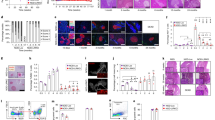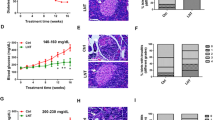Abstract
Type 1 diabetes (T1D) in non-obese diabetic (NOD) mice may be favored by immune dysregulation leading to the hyporesponsiveness of regulatory T cells and activation of effector T-helper type 1 (Th1) cells1. The immunoregulatory activity of natural killer T (NKT) cells is well documented2,3, and both interleukin (IL)-4 and IL-10 secreted by NKT cells have important roles in mediating this activity4,5. NKT cells are less frequent and display deficient IL-4 responses in both NOD mice6,7 and individuals at risk for T1D (ref. 8), and this deficiency may lead to T1D (refs. 1,6–9). Thus, given that NKT cells respond to the α-galactosylceramide (α-GalCer) glycolipid in a CD1d-restricted manner by secretion of Th2 cytokines10,11,12, we reasoned that activation of NKT cells by α-GalCer might prevent the onset and/or recurrence of T1D. Here we show that α-GalCer treatment, even when initiated after the onset of insulitis, protects female NOD mice from T1D and prolongs the survival of pancreatic islets transplanted into newly diabetic NOD mice. In addition, when administered after the onset of insulitis, α-GalCer and IL-7 displayed synergistic effects, possibly via the ability of IL-7 to render NKT cells fully responsive to α-GalCer. Protection from T1D by α-GalCer was associated with the suppression of both T- and B-cell autoimmunity to islet β cells and with a polarized Th2-like response in spleen and pancreas of these mice. These findings raise the possibility thatα-GalCer treatment might be used therapeutically to prevent the onset and recurrence of human T1D.
This is a preview of subscription content, access via your institution
Access options
Subscribe to this journal
Receive 12 print issues and online access
$209.00 per year
only $17.42 per issue
Buy this article
- Purchase on Springer Link
- Instant access to full article PDF
Prices may be subject to local taxes which are calculated during checkout




Similar content being viewed by others
References
Delovitch, T.L. & Singh, B. The nonobese diabetic mouse as a model of autoimmune diabetes: Immune dysregulation gets the NOD. Immunity 7, 727–738 (1997).
Sonoda, K.H., Exley, M., Snapper, S., Balk, S.P. & Stein-Streilein, J. CD1-reactive natural killer T cells are required for development of systemic tolerance through an immune-privileged site. J. Exp. Med. 190, 1215–1226 (1999).
Godfrey, D.I., Hammond, K.J., Poulton, L.D., Smyth, M.J. & Baxter, A.G. NKT cells: facts, functions and fallacies. Immunol. Today 21, 573–83 (2000).
Yoshimoto, T. & Paul, W.E. CD4pos, NK1.1pos T cells promptly produce interleukin 4 in response to in vivo challenge with anti-CD3. J. Exp. Med. 179, 1285–1295 (1994).
Sonoda K.H. et al. NK T cell-derived IL-10 is essential for the differentiation of antigen-specific T regulatory cells in systemic tolerance. J. Immunol. 166, 42–50 (2001).
Baxter, A.G., Kinder, S.J., Hammond, K.J., Scollay, R. & Godfrey, D.I. Association between αbetaTCR+CD4−CD8− T-cell deficiency and IDDM in NOD/Lt mice. Diabetes 46, 572–582 (1997).
Gombert, J.M. et al. Early quantitative and functional deficiency of NK1+-like thymocytes in the NOD mouse. Eur. J. Immunol. 26, 2989–2998 (1996).
Wilson, S.B. et al. Extreme Th1 bias of invariant Vα24JαQ T cells in type 1 diabetes. Nature 391, 177–181 (1998).
Lehuen, A. et al. Overexpression of natural killer T cells protects Vα14- Jα281 transgenic nonobese diabetic mice against diabetes. J. Exp. Med. 188, 1831–1839 (1998).
Kawano, T. et al. CD1d-restricted and TCR-mediated activation of Vα14 NKT cells by glycosylceramides. Science 278, 1626–1629 (1997).
Burdin, N., Brossay, L. & Kronenberg, M. Immunization with α-galactosylceramide polarizes CD1-reactive NK T cells towards Th2 cytokine synthesis. Eur. J. Immunol. 29, 2014–2025 (1999).
Singh, N. et al. Activation of NK T cells by CD1d and α-galactosylceramide directs conventional T cells to the acquisition of a Th2 phenotype. J. Immunol. 163, 2373–2377 (1999).
Hammond, K.J.L. et al. α/β-T cell receptor (TCR)+CD4−CD8− (NKT) thymocytes prevent insulin-dependent diabetes mellitus in nonobese diabetic (NOD)/Lt mice by the influence of interleukin (IL)-4 and/or IL-10. J. Exp. Med. 187, 1047–1056 (1998).
Bendelac, A., Rivera M.N., Park S.H. & Roark J.H. Mouse CD1-specific NK1T cells: development, specificity, and function. Annu. Rev. Immunol. 15, 535–562 (1997).
Shevach, E.M. Regulatory T cells in autoimmunity. Annu. Rev. Immunol. 18, 423–449 (2000).
Brossay, L. et al. CD1d-mediated recognition of an α-galactosylceramide by natural killer T cells is highly conserved through mammalian evolution. J. Exp. Med. 188, 1521–1528 (1998).
Hameg, A. et al. A subset of NKT cells that lacks the NK1.1 marker, expresses CD1d molecules, and autopresents the α-galactosylceramide antigen. J. Immunol. 165, 4917–26 (2000).
Gombert, J.M. et al. IL-7 reverses NK1+ T cell-defective IL-4 production in the non-obese diabetic mice. Int. Immunol. 8, 1751–1758 (1996).
Vicari, A. et al. NK1.1+ T cells from IL-7-deficient mice have a normal distribution and selection but exhibit impaired cytokine production. Int. Immunol. 8, 1759–1766 (1996).
Yasunami, R. & Bach, J.F. Anti-suppressor effect of cyclophosphamide on the development of spontaneous diabetes in NOD mice. Eur. J. Immunol. 18, 481–484 (1988).
Ikehara, Y. et al. CD4(+) Vα14 natural killer T cells are essential for acceptance of rat islet xenografts in mice. J. Clin. Invest. 105, 1761–1767 (2000).
Seino Ki, K. et al. Requirement for natural killer T (NKT) cells in the induction of allograft tolerance. Proc. Natl. Acad. Sci. USA 98, 2577–2581 (2001).
Tori, M. et al. Proliferation of donor-derived NKR-P1+TCR α β+ (NKT) cells in the nonrecurrent spontaneous diabetic BB rats transplanted with pancreatic duodenal grafts of Wistar-Furth donors. Transplant. Proc. 31, 2741–2742 (1999).
Rabinovitch, A.O. Suarez-Pinzon, W.L. Sorensen, O. Rajotte, R.V. & Power, R.F. Combination therapy with cyclosporine and interleukin-4 or interleukin-10 prolongs survival of synergeneic pancreatic islet grafts in nonobese diabetic mice: islet graft survival does notcorrelate with mRNA levels of type 1 or type 2 cytokines, or transforming growth factor-beta in the islet grafts. Transplantation 64, 1525–1531 (1997).
Matsuda, J.L. et al. Tracking the response of natural killer T cells to a glycolipid antigen using CD1d tetramers. J. Exp. Med. 192, 741–754 (2000).
Lepault, F., Gagnerault, M.C., Faveeuw, C., Bazin, H. & Boitard, C. Lack of L-selectin expression by cells transferring diabetes in NOD mice: Insights into the mechanisms involved in diabetes prevention by Mel-14 antibody treatment. Eur. J. Immunol. 25, 1502–1507 (1995).
Salomon, B. et al. B7/CD28 costimulation is essential for the homeostasis of the CD4+CD25+ immunoregulatory T cells that control autoimmune diabetes. Immunity 12, 431–440 (2000).
Herbelin, A., Gombert, J.M., Lepault, F., Bach, J.F. & Chatenoud, L. Mature mainstream TCRαβ+CD4+ thymocytes expressing L-selectin mediate “active tolerance” in the nonobese diabetic mouse. J. Immunol. 161, 2620–2628 (1998).
Lepault, F. & Gagnerault, M.C. Characterization of peripheral regulatory CD4+ T cells that prevent diabetes onset in nonobese diabetic mice. J. Immunol. 164, 240–247 (2000).
Hong, S. et al. The natural killer T-cell ligand α-galactosylceramide prevents autoimmune diabetes in non-obese diabetic mice. Nature Med. 7, 1052–1056 (2001).
Osman, Y. et al. Activation of hepatic NKT cells and subsequent liver injury following administration of α-galactosylceramide. Eur. J. Immunol. 30, 1919–1928 (2000).
Van Der Vliet, H.J. et al. Effects of α-galactosylceramide (KRN7000), interleukin-12 and interleukin-7 on phenotype and cytokine profile of human Vα24+Vαβ11+ T cells. Immunology 98, 557–563 (1999).
Laloux, V., Beaudoin, L., Jeske, D., Carnaud, C. & Lehuen, A. NKT cell-induced protection against diabetes in Vα14-Jα281 transgenic NOD mice is associated with a Th2 shift circumscribed regionally to the islets and functionally to islet auto-antigen. J. Immunol. 166, 749–3756 (2001).
Acknowledgements
We thank L. Van Kaer for sharing his findings before publication and for providing mutant CD1d-deficient mice; S. Chakrabarti and K. Mukerjee for their assistance with pancreas histology analyses; O. Babin and M.C. Gagnerault for technical assistance; E. Schneider for critical reading of the manuscript; all members of our laboratories for advice and encouragement; O. Lantz and D. Mouton for advice on kinetic PCR and OVA immunization, respectively; and the Sanofi Co. and A. Bendelac for providing human rIL-7 and antibody against CD1d, respectively. This work was supported by grants from the Juvenile Diabetes Research Foundation International, Canadian Institutes of Health Research and London Health Sciences Center Multi-Organ Transplant Program (to T.L.D.), a postdoctoral fellowship from the Canadian Diabetes Association (to S.S.) and a grant from the Fondation pour la Recherche Medicale (to A.H.).
Author information
Authors and Affiliations
Corresponding authors
Rights and permissions
About this article
Cite this article
Sharif, S., Arreaza, G., Zucker, P. et al. Activation of natural killer T cells by α-galactosylceramide treatment prevents the onset and recurrence of autoimmune Type 1 diabetes. Nat Med 7, 1057–1062 (2001). https://doi.org/10.1038/nm0901-1057
Received:
Accepted:
Issue Date:
DOI: https://doi.org/10.1038/nm0901-1057
This article is cited by
-
Repeated administration of alpha-galactosylceramide ameliorates experimental lupus nephritis in mice
Scientific Reports (2018)
-
A locus on mouse chromosome 13 inversely regulates CD1d expression and the development of invariant natural killer T-cells
Genes & Immunity (2015)
-
Disposal of iNKT cell deficiency and an increase in expression of SLAM signaling factors characterizes sarcoidosis remission: a 4-year longitudinal study
Respiratory Research (2014)
-
Natural killer T cells: drivers or passengers in preventing human disease?
Nature Reviews Immunology (2014)
-
(S)-Garner aldehyde derived Baylis-Hillman adduct: A potential substrate for the synthesis of D-lyxo phytosphinosine analogue
Journal of Chemical Sciences (2014)



